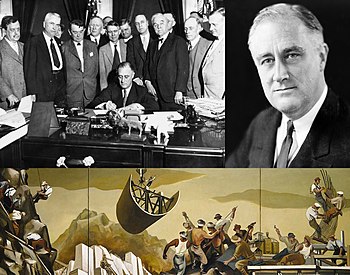
Back الصفقة الجديدة Arabic New Deal AST Ruzveltin yeni kursu Azerbaijani Новы курс Рузвельта Byelorussian Нов курс на Рузвелт Bulgarian New Deal BS New Deal Catalan New Deal Czech Y Fargen Newydd Welsh New Deal Danish
 Top left: The TVA Act signed into law in 1933 Top right: President Franklin D. Roosevelt led the New Dealers; Bottom: A public mural from the arts program | |
| Location | United States |
|---|---|
| Type | Economic program |
| Cause | Great Depression |
| Organized by | President Franklin D. Roosevelt |
| Outcome | Reform of Wall Street; relief for farmers and unemployed; social security; political power shifts to Democratic New Deal Coalition |
The New Deal was a series of programs, public work projects, financial reforms, and regulations enacted by President Franklin D. Roosevelt in the United States between 1933 and 1938. Major federal programs and agencies, including the Civilian Conservation Corps (CCC), the Works Progress Administration (WPA), the Civil Works Administration (CWA), the Farm Security Administration (FSA), the National Industrial Recovery Act of 1933 (NIRA) and the Social Security Administration (SSA), provided support for farmers, the unemployed, youth, and the elderly. The New Deal included new constraints and safeguards on the banking industry and efforts to re-inflate the economy after prices had fallen sharply. New Deal programs included both laws passed by Congress as well as presidential executive orders during the first term of the presidency of Franklin D. Roosevelt.
The programs focused on what historians refer to as the "3 R's": relief for the unemployed and for the poor, recovery of the economy back to normal levels, and reform of the financial system to prevent a repeat depression.[1] The New Deal produced a political realignment, making the Democratic Party the majority (as well as the party that held the White House for seven out of the nine presidential terms from 1933 to 1969) with its base in progressive ideas, the South, big city machines and the newly empowered labor unions, and various ethnic groups. The Republicans were split, with progressive Republicans in support but conservatives opposing the entire New Deal as hostile to business and economic growth. The realignment crystallized into the New Deal coalition that dominated presidential elections into the 1960s and the opposing conservative coalition largely controlled Congress in domestic affairs from 1937 to 1964.
- ^ Carol Berkin; et al. (2011). Making America, Volume 2: A History of the United States: Since 1865. Cengage Learning. pp. 629–632. ISBN 978-0-495-91524-9.
© MMXXIII Rich X Search. We shall prevail. All rights reserved. Rich X Search